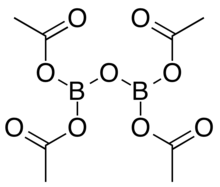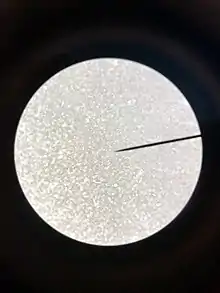 | |
| Names | |
|---|---|
| IUPAC name
[acetyloxy(diacetyloxyboranyloxy)boranyl] acetate | |
Other names
| |
| Identifiers | |
3D model (JSmol) |
|
PubChem CID |
|
CompTox Dashboard (EPA) |
|
| |
| |
| Properties | |
| C8H12B2O9 | |
| Molar mass | 273.80 g·mol−1 |
| Appearance | Colorless needles |
| Melting point | 147 °C (297 °F; 420 K) |
| Solubility | Soluble in most organic solvents |
| Hazards | |
| Flash point | Not flammable |
Except where otherwise noted, data are given for materials in their standard state (at 25 °C [77 °F], 100 kPa).
Infobox references | |

Tetraacetyl Diborate crystals observed under a microscope.
Tetraacetyl diborate is an organoboron compound with the molecular formula (CH3COO)2BOB(CH3COO)2.
Preparation
It is not well known and was discovered accidentally by an attempt trying to make boron triacetate in the 1950s. It was made by reacting boric acid and acetic anhydride around 75 °C (167 °F) under nitrogen which created tetraacetyl diborate and acetic acid. It crystallized as a colorless solid.[1]
- 2H3BO3 + 5(CH3CO)2O → (CH3COO)2BOB(CH3COO)2 + 6CH3COOH
Reactions
Tetraacetyl diborate reacts with methanol to form water and diacetyl methoxyboron.[1]
References
- 1 2 3 R. G. Hayter; A. W. Laubengayer; P. G. Thompson (1957). "Tetraacetyl Diborate and So-Called "Boron Acetate"". Journal of the American Chemical Society. 79 (15): 4243–4244. doi:10.1021/ja01572a075.
- ↑ "Tetraacetyl diborate". PubChem. PubChem. Retrieved 18 February 2021.
This article is issued from Wikipedia. The text is licensed under Creative Commons - Attribution - Sharealike. Additional terms may apply for the media files.